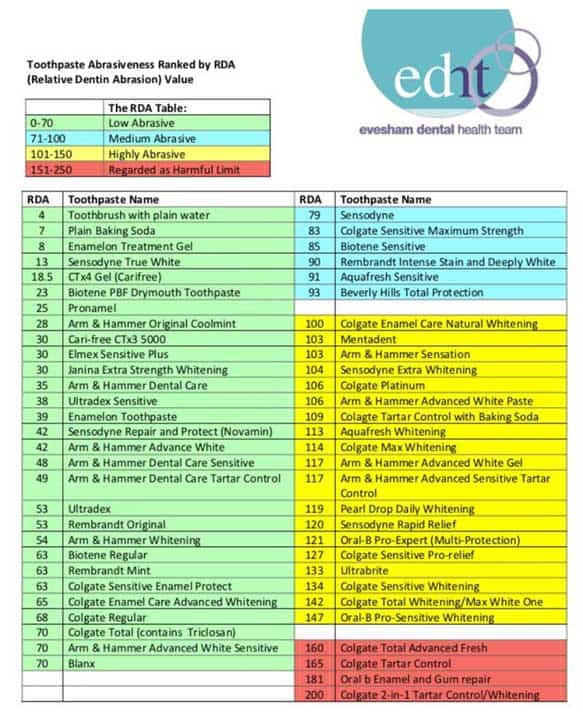Acid (dental) erosion or erosive tooth wear is just one form of dental tooth wear. Tooth wear is the combined loss of hard (mineralised) tooth surfaces due to the effect of chemical (e.g. acids) and/or mechanical (e.g. grinding) action. The hard outer covering of the tooth, enamel and the softer dentine that lies underneath the enamel, can be destroyed.
While tooth wear is part of aging, it can occur at any age and may effect both baby and permanent teeth. If tooth wear is severe it can affect both the function and the appearance of teeth. It is important to identify the cause of toothwear in order to manage the condition.
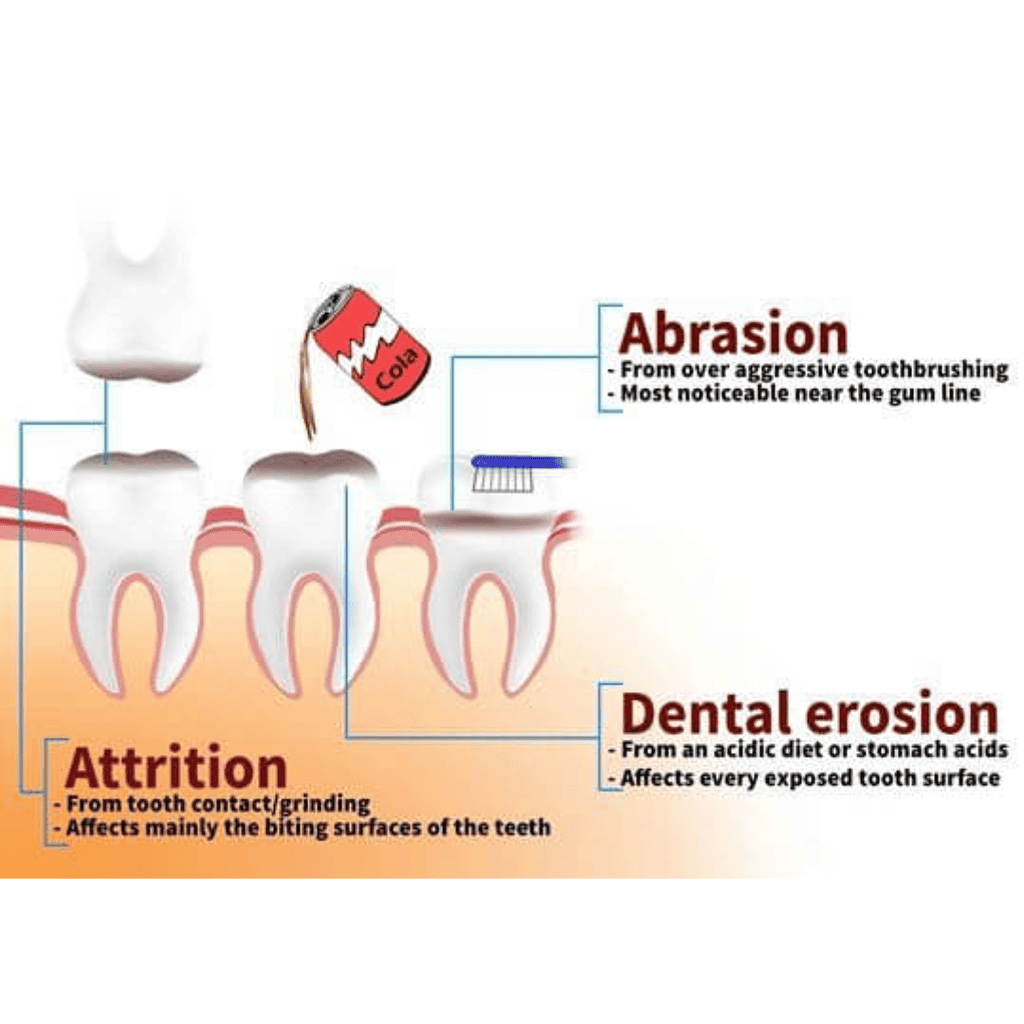
Often damage to tooth surfaces is the result of a combination of erosion, attrition and abrasion. Severe tooth wear rarely happens without some acid erosion contributing to the overall loss of tooth surfaces. Tooth wear by attrition e.g. tooth grinding (physical wear from tooth to tooth contact), and abrasion where tooth surface is lost by objects other than teeth e.g. toothbrush, tongue piercing contributw with erosion to overall tooth wear. The exposed dentine may be sensitive – dentine hypersensitivity.
Sip water instead of fizzy drinks.
Acids in the mouth can come from acidic food/drinks etc placed in the mouth e.g. drinking fruit juice and fizzy drinks, or internal acids from the stomach e.g. gastric reflux. Whatever the source, acid erosion will soften tooth surfaces and can lead to sensitivity and tooth surface loss, which can impact your quality of life.
Even if fizzy drinks are sugar free they are likely to be acidic due to the carbonation that gives them the ‘fizz’. The ‘fizz’ makes the drink more acidic, no matter the flavour.
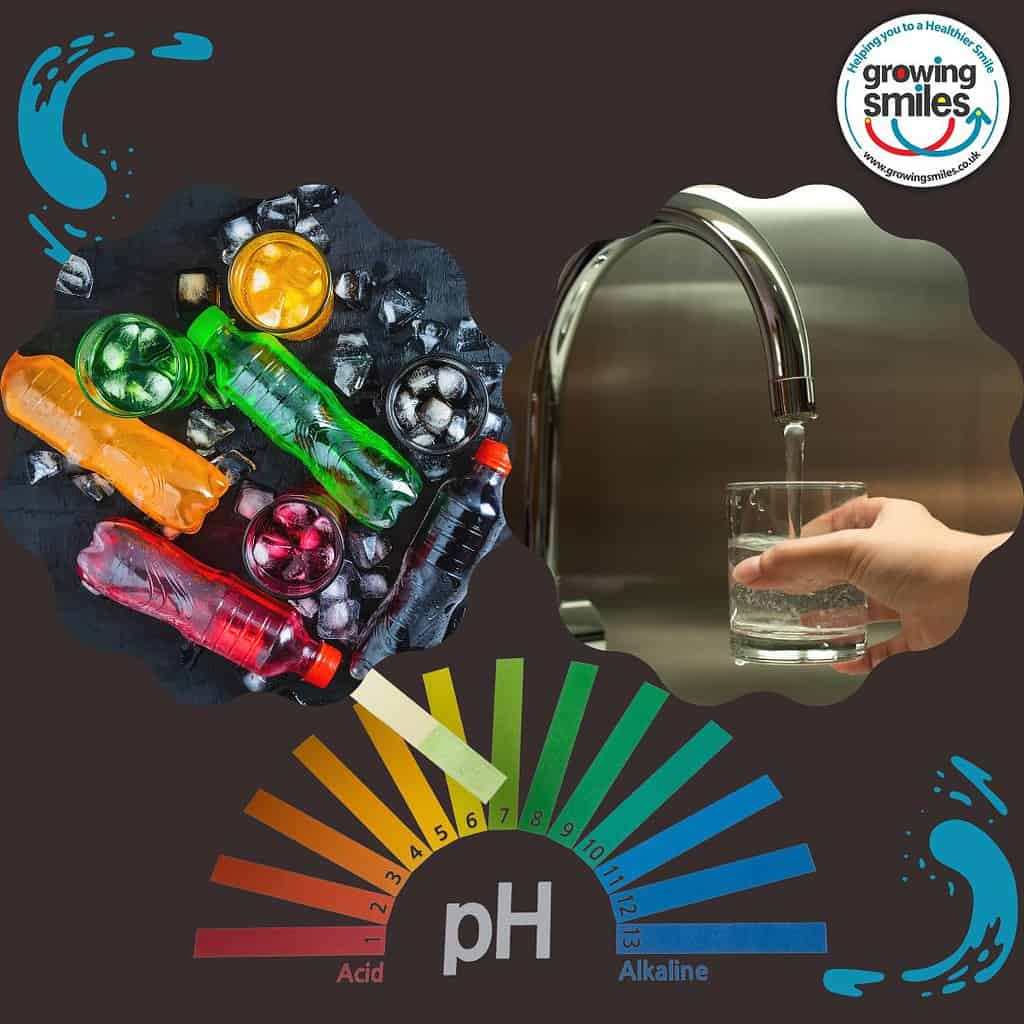
Generally the term tooth wear is used to describe tooth surface loss due to one or a combination of attrition, abrasion and erosion. The result of severe tooth wear can be poor appearance of teeth and sensitivity. It is important that the cause of tooth wear is identified and steps taken to prevent and manage wear. Your dentist will assess tooth wear during your oral health assessment and review appointments.
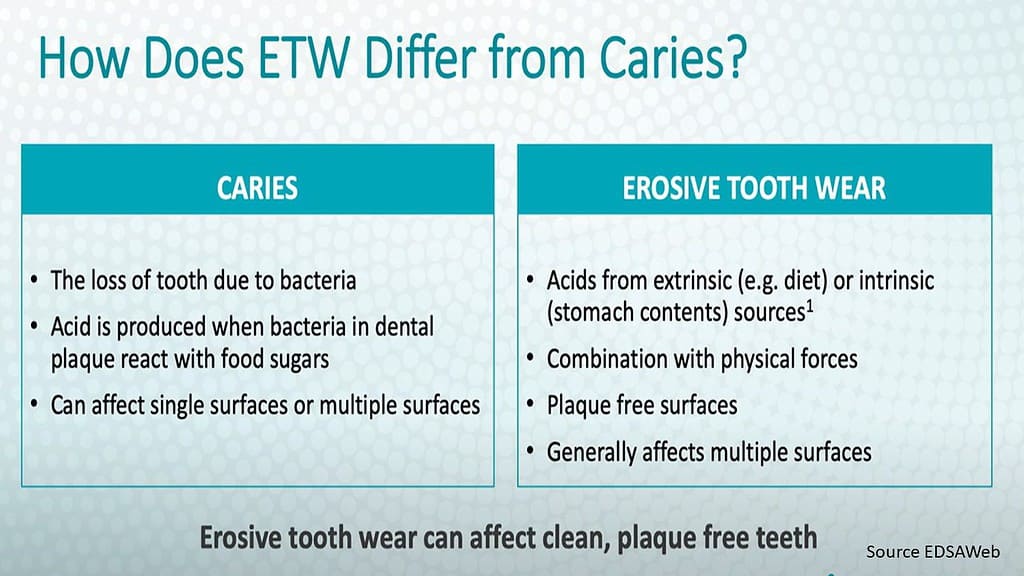
The difference between Erosive Tooth Wear ( ETW) and tooth decay (caries).
If you grind your teeth and have gastric reflux, tooth wear will be greater. Acid softens the tooth surfaces, making them easier to wear down. If you brush your teeth after an acid attack e.g vomiting, then the acid softened tooth surfaces may be worn more rapidly by toothbrush bristles, especially if using an abrasive toothpaste or tooth powder and a hard-bristled toothbrush. DO NOT brush your teeth immediately after vomiting or gastric reflux. Rinse your mouth with water or fluoride mouth rinse.

Learn more about erosive tooth wear from the experts.
Tooth wear is a relatively slow process and to some extent is a natural part of ageing. Your dental team will monitor any wear in your mouth and discuss concerns. Always tell your dental team if you suffer from frequent vomiting or gastric reflux and talk to them about what can be done to prevent or limit any potential damage from acid erosion.
The impact of acids on your mouth depends on the pH (expresses the acidity or alkalinity of a solution on a scale on which 7 is neutral, lower values are more acid and higher values more alkaline), the titratable acidity (the measure of the amount of acid present in a solution), and the chemical composition of the acid. Enamel will start to demineralise with a pH of 5.5 and dentine at 6.4. The table below gives you an idea of the acidity of some common food and drinks. Your risk of suffering from acid erosion related tooth wear is dependent on a number of factors – which may change throughout life. These include the quality and quantity of saliva. The more often and longer acids are in the mouth the more likely you are to suffer from acid erosion. An early indication of acid erosion can be tooth sensitivity. If you are concerned talk to your dental team or Growing Smiles Oral Health Coach.
PH Scale
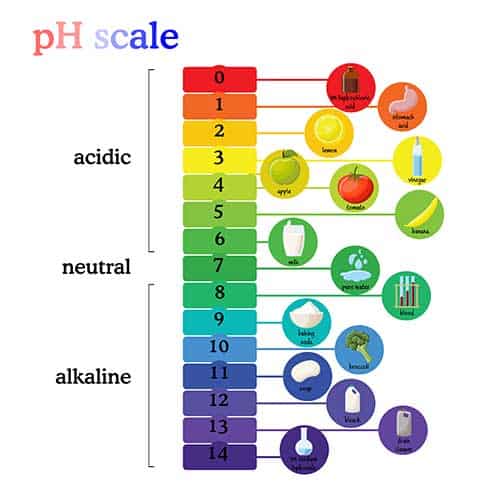
Growing Smiles top tips for controlling acid erosion.
- Eat a healthy diet at regular mealtimes (see Eatwell guide below https://www.nutrition.org.uk/healthyliving/healthydiet/eatwell.html) rather than ‘grazing’ throughout the day.
- Use low abrasive, high fluoride toothpaste (1450ppm) at night time and in the morning. Spit out after brushing but don’t rinse. See table of relative dentine abrasion (RDA) of toothpastes below. Look for one that has fluoride and a stannous based ingredient, or a paste specifically for erosive tooth wear to aid remineralisation.
- Brush before rather than after breakfast. While there isn’t strong evidence to support the timing of brushing as important, it is best not to brush immediately after acidic food/drink or after vomiting. Leave 45-60 minutes. If you want to freshen your mouth after vomiting smear a little toothpaste around or use a fluoride mouth rinse.
- Keep acidic food and drinks to mealtimes.
- Chew sugar free gum after eating and drinking.
- Use an alcohol-free fluoride mouth rinse at a different time to brushing.
- If you suffer from a medical condition that causes acid reflux e.g. gastric reflux, eating disorder etc speak to your Doctor.
- Check any medications taken regularly are acid free e.g vitamin C , aspirin, iron preparations.
- Saliva flow is important in diluting acids, buffering (neutralising) acids and clearing foods. If your mouth is dry you may be at increased risk of tooth wear – learn more here.
- Use products that aid remineralisation to harden and protect tooth surfaces as well as a suitable toothpaste. Think of it as moisturiser for your teeth.
NB. Any medication that has a side effect of dry mouth can impact your risk of acid erosion and tooth surface loss. Some medications are acidic e.g. Vitamin C, Aspirin and some Iron preparations. Speak to your Doctor or Dentist.
Eatwell Guide
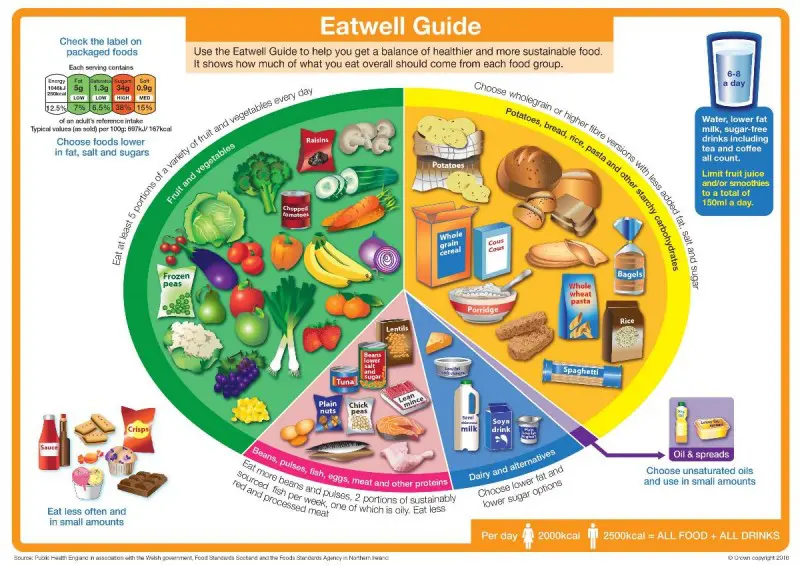
Sources of acid that may lead to erosive tooth wear (From Delivering Better Oral Health 2021)
Extrinsic sources of acid
Drinks • carbonated drinks (except non-flavoured sparkling water)
• wine (white and red)
• alcopops and designer drinks
• fortified wines with fruity flavours
• smoothies
• energy drinks
• drinks containing citric acid, including natural fruit juices – such as orange, grapefruit, lemon, blackcurrant
• fruit teas (excluding non-fruit flavoured herbal teas such as camomile or peppermint)
• sports drinks
Foods • vinegar-based foods, including pickles
• fruit-based sauces
Confectionary • acidic sweets, for example sour jelly-based sweets, acid drops, sherbet lemons, and so on
• fruit-based sugar and certain sugar free sweets
Fruit (healthy acids) • acidic fresh fruit, particularly in high quantities
• lemons, oranges and grapefruit are the most acidic fruit acids (most fruits may be erosive, other than banana and avocado)
Medication • chewable vitamin C tablets
• aspirin
• asthmatic inhalers
• some iron preparations
Reduced saliva Dry mouth • conditions which reduce salivary flow including intense sport and anxiety
• saliva reducing medications
Chemicals • tooth whitening materials
Other – rare sources • occupational exposure to acid, for example mists in the workplace air, wine tasters
• swimming
Intrinsic sources of acid (Chemical wear)
Eating disorders including bulimia nervosa
Gastric acid reflux including GORD (gastro oesophageal reflux disease) Laryngopharyngeal reflux (LPR)
Chronic vomiting
Sources of mechanical tooth wear (from Delivering Better Oral Health 2021)
Mechanical wear
Tooth brushing – aggressive/inappropriate technique
Abrasive Toothpaste
Piercings
Bruxism (grinding teeth)

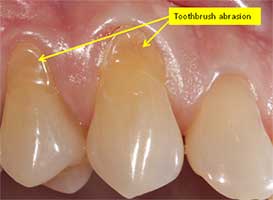
The RDA Table
